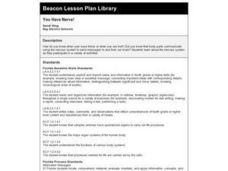Curated OER
Diversity And Adaptations Of Organisms
Seventh graders demonstrate the processes of science by posing questions and investigating phenomena through language, methods and instruments of science. They study the body features or systems of several animals.
Curated OER
You Have Nerve!
Fourth graders investigate the nervous system and how it communicates messages to and from the brain.
Curated OER
Diseases of the Eye
Fifth graders research diseases of the eye. In this science lesson, 5th graders discuss and research eye diseases and complete a worksheet using the information they find.
Curated OER
Human Anatomy
Students use the web to explain how the bones serve as protection for organs in the body and recognize some of the bone structure that protect certain organs. They comprehend the different structure and functions of support tissue...
Curated OER
Apoptosis: Programmed Cell Death During Development
Students model the plasticity of neural pathways for memory in the brain. They simulate the cell activity according to dots on cards that they are given. They complete various simulations of different cell combinations.
Curated OER
Cells Brochure
Students examine the structure and functions of an animal or plant cell. They view an online video about cells, conduct Internet research on the Brain Pop website, and create an informational brochure about cell structure and functions.
Curated OER
Good Senses
Young scholars examine how the brain can link or senses and how our tongue determines the basic tastes. In this five senses lesson students complete a taste test.
Curated OER
Sense Organs & Body Systems: Cool Facts & Trivia
In this sense organs and body functions activity, students answer true and false questions about sense organs and body functions. Students complete 13 questions.
Curated OER
What Does Your "Homunculus" Look Like?
Students determine the density of touch receptors in various parts of the body on the right hand side. They use collected data to draw a picture of the
"homunculus" of an experimental subject.
Curated OER
Neuron Cookie
Find out just how enticing learning about neurons can be by creating models with sugar cookies, icing, and candy. With great background information for you and an easy procedure for the kids, studying cells has never been more fun or...
Serendip
How Do We Sense the Flavors of Food?
We taste with our taste buds, so why do flavors change when we have a stuffy nose? Scholars experiment with taste testing while holding their noses and then while smelling. They record their observations in pairs and come together to...
University of Minnesota
Connect the Neurons!
Create a neuron frenzy as your pupils play the part of the neurons. An engaging lesson plan creates a human chain of neurons that pass cotton balls posing as neurotransmitters. Scholars learn about pre- and post-synapses as they...
University of Minnesota
Neurotransmission Model
Don't lose your marbles — you'll need them for a instructional activity on neurotransmission. Young scholars build a neurotransmission model using marbles, beads, rubber bands, string, and other elements. After studying specific...
Curated OER
The Nobel Prize in Chemistry 2003 - Information for the Public
An information-packed eight-page article detailing the history of understanding active transport across cell membranes makes up the bulk of this handout. Two pages of reading comprehension and critical-thinking questions follow. The...
LABScI
Vision Lab: The Eye
Our bodies have some amazing capabilities, but there are some limitations. Explore the limitations of the human eye through the eighth lab activity in a series of 12 biology lessons. Individuals measure their own peripheral vision...
Rochester Institute of Technology
Artificial Eye
Scientists in California developed a bionic eye that allows blind people to see edges of objects in black and white and costs $145,000. In the activity, groups of scholars discuss bioengineering, focusing on the human eye. They then...
Curated OER
Health Physics: The Effects of Radiation on Living Things
A mix of scientific details and background information about the well-known sites of radiation attacks or accidents. This topic may open up details that you may consider as sensitive, and could be upsetting to some pupils. This is a...
Curated OER
Mapping the Homunculus
Students determine the relative number of nerve endings located in the skin. By calculating the reciprocal of these measurements, students have the appropriate data for predicting the relative size of the homunculus found on the cerebral...
Curated OER
A Difference of Mind
Students discover the individual variance in brain response to its four main functions. They perform activities related to each function at four stations set up in the classroom. They discuss their responses as a class.
Curated OER
Regional Differences
Students examine how the brain sends and receives messages by assessing PET scans. They diagram areas of the brain that evaluate various situations. They discover that individuality is due to different responsesnin the brain.
Curated OER
Dreamweavers
Students watch a commericial on the brain due to substance use. They print their dreams on pieces of construction paper and share them in small groups. As a class, they weave their peces together to make a product
representative of their...
Curated OER
Drugs Change the Way Neurons Communicate
High schoolers examine that certain drugs interfere selectively with neurotransmission, and realize that the effect of a drug is dependent upon dosage and route of administration.
Curated OER
Breathing and Holding Your Breath
Five questions are presented and answered as a means of delivering information on the respiratory system. Using red and blue game chips, physiology learners model the movement of blood through the lungs. Groups of learners time how long...
Curated OER
Review for Strand 2A Test: Nervous System
Three pages containing 51 true and false questions make up this nervous system review. The major topics listed at the top of the test mention a film strip and a laboratory activity, but the questions appear to be answerable without...























